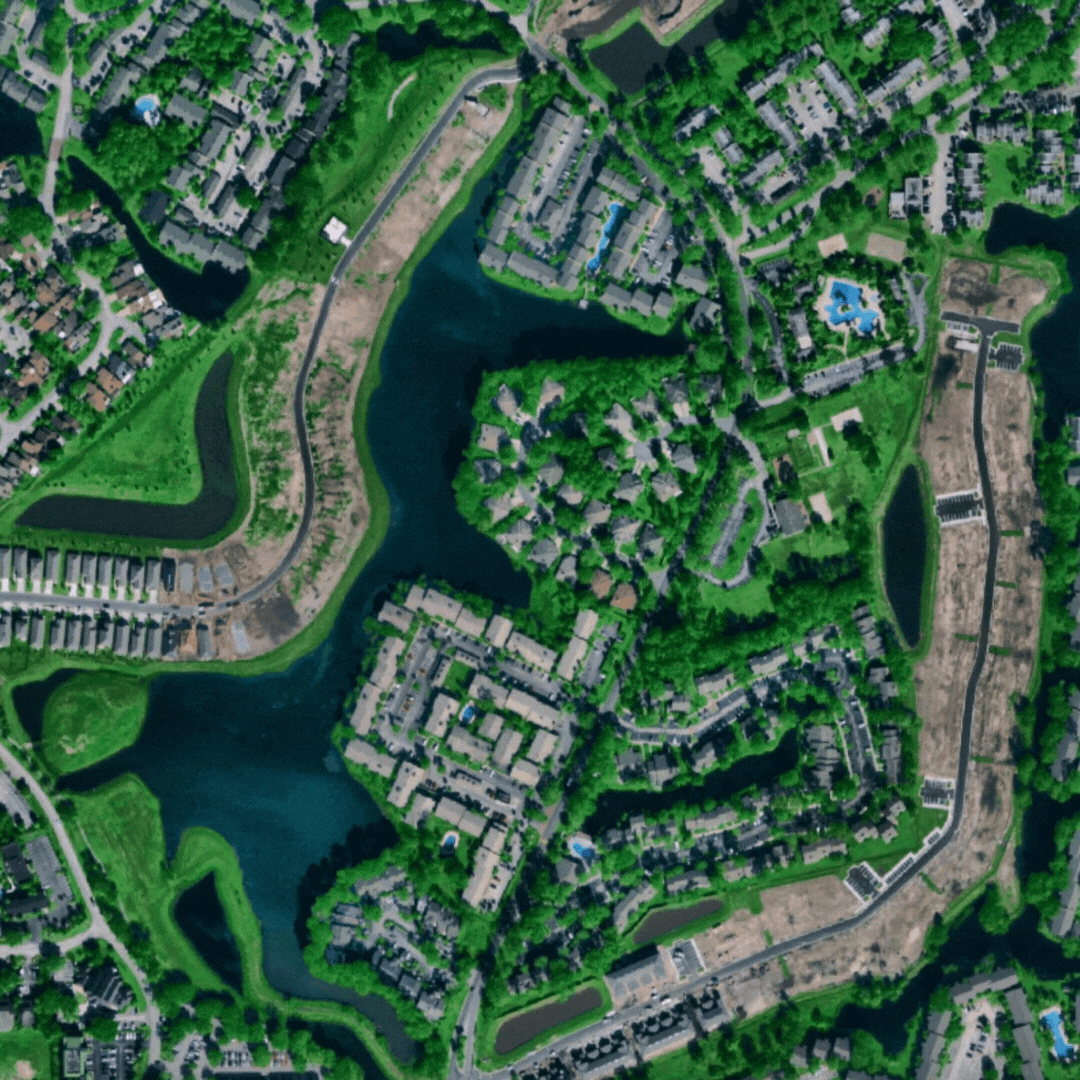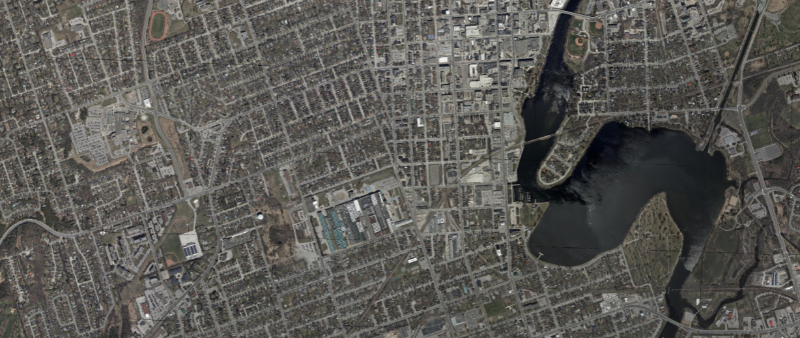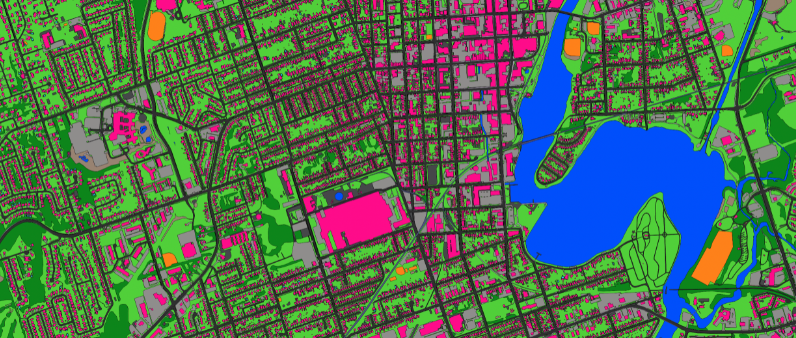When the image first appears, it is as disconcerting as it is shocking. Geometric shapes in bright pinks and greens vie for attention with bold lines that carve out the frames. The shapes are grouped, but there is no focal point. It could almost be modern art, maybe a Mondrian if it had too much caffeine around the neon paint.
But this is not cubism; it is cartography.
“We’re done with Italy,” Brandon Palin says with the authority of an expert tour guide. “You can tell by the structure of the buildings and the way the roads are.” We are looking at an aerial view of a small town displayed on a huge television screen in a downtown Toronto office. The bright neon colors come from a digital overlay that obscures much of the photograph. It takes a moment to get used to, but then it becomes clear that every building, street, bridge, waterway, part of the greenery, and countless other features have been meticulously highlighted.
According to Palin, the somewhat disordered layout of the houses is one of the clues that we are in southern Europe. And he should know: he is a senior director at AI Ecopia, a Toronto tech company that is putting Canada on the map for, well… maps. Growing out of one of the co-founder’s research projects at the University of Waterloo in 2013, the company specializes in using artificial intelligence to create hyper-precise digital graphics from high-resolution satellite, aerial and street view photography. Its technology is now deployed in more than 100 countries and its applications are endless. It’s being used by urban planners in Italy, 911 dispatchers in Florida, and last year the company won a multimillion-dollar contract with the US government to help it prepare for climate change.
At the touch of a button, Palin transports us to a Seattle suburb to examine how much shade the treetops provide. We then head to Jacksonville, where the previously top-down map becomes three-dimensional. This sight is from the next generation of Ecopia technology, and the detail is impressive. The exterior forms of the houses are so accurately rendered that you can just make out the quaint dormer roof windows beloved by suburban developers. The software can even determine what material the roof is made of and assess its condition.

The capabilities of this technology are enormous. It is the world captured, digitized and ready to be explored.
sailing the future
Climate change is intensifying the need for highly accurate maps. As sea levels rise and natural disasters multiply, governments, developers and insurers must predict the impact they could have and what solutions could help mitigate the impact. Google Maps, the highest profile player in the $20 billion digital mapping industry, is fine for getting from A to B and avoiding traffic on the way. But he can’t easily tell you which roofs might be suitable for solar panels or whether a vacant lot is bare earth, vegetation, or paved. Those can be vital details if he’s trying to plan for cleaner power infrastructure or determine where stormwater will end up in a severe storm.
Jon Lipinski, Ecopia’s co-founder and president, says the company is on a mission to build a virtual replica, or digital twin, in technological terms, of the entire planet that “reflects every detail of the real world and changes as they occur.” . .”
That last part is crucial. A warmer climate and rapidly growing urban areas are accelerating changes in the environment. Palin points to Florida communities that are flooding as mangroves, which once protected them by absorbing winds and storm surges, are cleared for development. “The infrastructure that was installed was designed when those mangroves still existed,” he says. These days, cartographers and planners have to run to stand still.
When high-resolution photography became widely available in the 1990s, extracting information from the map was a laborious task. Cartographers would trace the contours of structures manually or methodically check and correct the work of some rather unpredictable computer systems. The rise of artificial intelligence and the growth of computing power over the past decade has allowed mapping companies to automate this process, turning work that used to take weeks or months into days. Lipinski says the company’s secret sauce is its algorithms, which allow it to extract huge amounts of information quickly and accurately, while keeping file sizes at levels that won’t melt its users’ laptops. That speed also means you can quickly update your maps when new imagery is available.
marker placement
Ecopia’s technology has enabled it to achieve some notable achievements. It was the first company to map every building in the United States and created the most comprehensive map of sub-Saharan Africa. And it has also brought its technology to mapping vegetation such as trees, forests, and grasslands in unprecedented detail.
That work has drawn attention. The company was recently awarded a $10 million contract by the US National Oceanic and Atmospheric Administration to provide maps to support its climate resiliency planning, and Ecopia is now one of the companies state and local governments turn to since Illinois to Los Angeles.
Here in Canada, the city of Peterborough is using Ecopia data in its stormwater models, with the goal of preventing a repeat of the 2004 floods that caused tens of millions of dollars in damage. Traditionally, hydrologists had to rely on rough estimates of the amount of rainfall various surfaces could absorb. Ecopia’s technology allows planners to more accurately model water flows by accurately identifying non-porous surfaces such as pathways and roofs and determining whether or not they are connected to the city’s sewer system. The federal government also contracted with Ecopia to help plan broadband expansions, as well as to make detailed maps of Canada’s 100 largest cities to support zero-grid efforts, such as improving transit.


Ecopia’s wide range of activities reflects the fact that AI-generated maps are now the basis for a great deal of planning work. “Whether you’re asking for a home insurance quote, making a call on a 5G network, or relying on a stormwater drainage system, all of those things are based on mapping technology,” Lipinski says.
In this way, AI cartographers continue a tradition of mapmaking that shapes our world as much as it represents it. Maps have always prioritized certain elements over others: the Romans placed the Mediterranean at the center of the world, while representations such as the peter projection they have been produced to counteract the gross exaggeration of Northern Hemisphere countries on most modern maps. By emphasizing detail and the need for constant updates, the AI-generated graphics push the maps beyond their origins as static representations of a slowly evolving world. Now they are dynamic tools that help us react to an increasingly complex and rapidly changing planet.
“Maps are critical to understanding change,” says Palin. “Indeed, these data sets are the foundation for innovation.”
